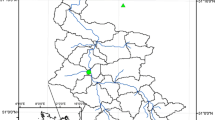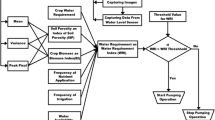Abstract
The spatial and temporal variability of a cultivated soil, with technified irrigation systems, requires adaptive control systems to the varying conditions of the water–soil–crop intersystem. Therefore, an adaptive control based on a Radial Basis Function Neural Network (RBF-NN) is proposed in this paper. A static Proportional-Integral (PI) controller was tuned without modifying its parameters by adding a compensation based on RBF-NNs. In this way, the dynamic variation is approximated in real time by means of a RBF-NN. The controller is tested in simulation from a model of water distribution in the soil with extraction by a crop. The results obtained with this method are compared with a traditional Proportional-Integral-Derivative (PID) controller. The comparisons are made taking into account compromise between the amount of water applied and irrigation frequency to keep soil moisture values within the allowed limits. Water savings of 20% and a reduced valve activations 2 times less than the traditional PID were achieved. Finally, the behavior of the controller in the event of disturbances was evaluated, verifying the rejection it produces in the face of these eventualities.






Similar content being viewed by others
Data availibility
The datasets generated during and/or analysed during the current study are available from the corresponding author on reasonable request.
References
Pandey V, Pandey PK (2010) Spatial and temporal variability of soil moisture. Int J Geosci 1(02):87
Jaramillo JDF (2012) Spatial variability of soil: basis for its study. Revista de la Facultad de Ciencias 1(1):73–87
Bramley RG (2009) Lessons from nearly 20 years of precision agriculture research, development, and adoption as a guide to its appropriate application. Crop Pasture Sci 60(3):197–217
Vita Serman F, Orgaz F, Starobinsky G, Capraro F, Fereres E (2021) Water productivity and net profit of high-density olive orchards in san juan, argentina. Agric Water Manag 252:106878. https://doi.org/10.1016/j.agwat.2021.106878
Smith RJ, Baillie JN, McCarthy AC, Raine SR, Baillie CP (2010) Review of precision irrigation technologies and their application. Technical report. http://eprints.usq.edu.au/id/eprint/23261
Khosla R, Westfall DG, Reich RM, Mahal JS, Gangloff WJ (2010) In: Oliver, M.A. (ed.) Spatial variation and site-specific management zones, pp 195–219. Springer, Dordrecht
Woo DK, Riley WJ, Grant RF, Wu Y (2022) Site-specific field management adaptation is key to feeding the world in the 21st century. Agricultural and forest meteorology 327. https://doi.org/10.1016/j.agrformet.2022.109230
Hedley CB, Yule IJ (2009) Soil water status mapping and two variable-rate irrigation scenarios. Precis Agric 10(4):342–355
Pierce F (2010) Precis Irrig Landbauforsch SH 340:45–56
Monaghan JM, Daccache A, Vickers LH, Hess TM, Weatherhead EK, Grove IG, Knox JW (2013) More ‘crop per drop’: constraints and opportunities for precision irrigation in european agriculture. J Sci Food Agric 93(5):977–980
Coates RW, Delwiche MJ (2008) Site-specific water and chemical application by wireless valve controller network. In: 2008 Providence, Rhode Island, American society of agricultural and biological engineers, pp 1
Modina D, Bianchi D, Ortuani B, Mayer A, Spadaccini R, Brancadoroa L (2021) Variable rate irrigation in a vineyard and an orchard. Acta Hort 1314:109–116
Adeyemi O, Grove I, Peets S, Norton T (2017) Advanced monitoring and management systems for improving sustainability in precision irrigation. Sustainability 9(3):353
McCarthy AC, Hancock NH, Raine SR (2010) Variwise: a general-purpose adaptive control simulation framework for spatially and temporally varied irrigation at sub-field scale. Comput Electron Agric 70(1):117–128
Capraro F, Patiño D, Tosetti S, Schugurensky C (2008) Neural network-based irrigation control for precision agriculture. In: 2008 IEEE International conference on networking, Sensing and Control, pp 357–362
Karasekreter N, Başçiftçi F, Fidan U (2013) A new suggestion for an irrigation schedule with an artificial neural network. J Exp Theor Artif Intell 25(1):93–104
Lyu L, Caballero JM, Juanatas RA (2022) Design of irrigation control system for vineyard based on lora wireless communication and dynamic neural network. In: 2022 7th International conference on business and industrial research (ICBIR), pp 373–378. https://doi.org/10.1109/ICBIR54589.2022.9786439
Thakur A, Aggarwal P, Dubey AK, Abdelgawad A, Rocha A (2023) Design of decision model for sensitive crop irrigation system. Expert Syst 40(1):13119. https://doi.org/10.1111/exsy.13119
Hu G, You F (2022) Renewable energy-powered semi-closed greenhouse for sustainable crop production using model predictive control and machine learning for energy management. Renew Sustain Energy Rev 168:112790. https://doi.org/10.1016/j.rser.2022.112790
Pazouki E (2023) Optimizing an irrigation treatment using an evolutionary algorithm and a knowledge discovery framework based on deep models. Appl Soft Comput 133:109940. https://doi.org/10.1016/j.asoc.2022.109940
Glória A, Cardoso J, Sebastião P (2021) Sustainable irrigation system for farming supported by machine learning and real-time sensor data. Sensors 21(9):3079. https://doi.org/10.3390/s21093079
Arbat G, Puig-Bargués J, Duran-Ros M, Barragan J, Cartagena F (2013) Drip-Irriwater: computer software to simulate soil wetting patterns under surface drip irrigation. Comput Electron Agric 98:183. https://doi.org/10.1016/j.compag.2013.08.009
Vrugt J, Hopmans J, Simunek J (2001) Jiri: calibration of a two-dimensional root water uptake model. Fluid Phase Equilib 65:1027–1037. https://doi.org/10.2136/sssaj2001.6541027x
Gomez JA, Rossomando F, Capraro F, Soria C (2022) Real-time neuro-adaptive pi control of soil moisture using a hybrid model. Revista Iberoamericana de Automática e Informática industrial 20(1):93–103
Allen RG, Pereira LS, Raes D, Smith M (2006) Crop evapotranspiration: guidelines for determining crop water requirements. FAO Roma Italia 300(9):D05109
Feddes R, Hoff H, Bruen M, Dawson T, De Rosnay P, Dirmeyer P, Jackson R, Kabat P, Kleidon A, Lilly A, Pitman A (2001) Modeling root water uptake in hydrological and climate models. Bull Am Meteorol Soc 82(12):2797–2809
Cybenko GV (1989) Approximation by superpositions of a sigmoidal function. Math Control Signals Syst 2:303–314
Haykin S (1999) Neural networks: a comprehensive foundation. Int Edit Prentice Hall 4:409–12
Schaap M, Leij F, Van Genuchten M (2001) Rosetta: a computer program for estimating soil hydraulic parameters with hierarchical Pedotransfer functions. J Hydrol 251:163–176. https://doi.org/10.1016/S0022-1694(01)00466-8
Acknowledgements
This work has been carried out thanks to the support of the Universidad Nacional de San Juan and the Consejo Nacional de Investigaciones Científicas y Técnicas (CONICET) of Argentina.
Author information
Authors and Affiliations
Corresponding author
Ethics declarations
Conflict of interest
The authors declare that they have no known competing financial interests or personal relationships that could have appeared to influence the work reported in this paper.
Additional information
Publisher's Note
Springer Nature remains neutral with regard to jurisdictional claims in published maps and institutional affiliations.
Rights and permissions
Springer Nature or its licensor (e.g. a society or other partner) holds exclusive rights to this article under a publishing agreement with the author(s) or other rightsholder(s); author self-archiving of the accepted manuscript version of this article is solely governed by the terms of such publishing agreement and applicable law.
About this article
Cite this article
Gomez, J.A., Rossomando, F., Capraro, F. et al. Neural compensator for PI soil moisture control. Neural Comput & Applic 35, 19131–19144 (2023). https://doi.org/10.1007/s00521-023-08723-6
Received:
Accepted:
Published:
Issue Date:
DOI: https://doi.org/10.1007/s00521-023-08723-6




